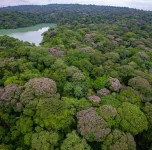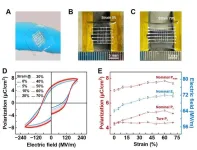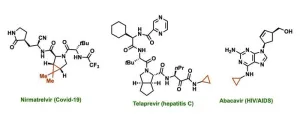(Press-News.org) UCF, MIT Designing Technology To Fight Bacterial Infections, Improve Aquaculture Farming
BY SUHTLING WONG | AUGUST 3, 2023 11:11 AM
UCF and MIT researchers are using farm-raised seafood as a model to create new technologies that fight pathogenic bacteria.
University of Central College of Medicine microbiologist Dr. Salvador Almagro-Moreno and Massachusetts Institute of Technology's Dr. Otto Cordero were recently awarded a grant from the National Science Foundation to create synthetic microbiomes – communities of microorganisms – that will better protect aquatic environments from bacteria.
The team discovered that microbes are organized in “ecological modules” that could be mixed and matched to construct microbiomes to better fight pathogens. They are working with shrimp farms in Ecuador to build new microbial communities for aquaculture that will improve shrimp health.
About 50 percent of the seafood consumed worldwide is grown through aquaculture, according to the National Oceanic and Atmospheric Administration, and that number is expected to increase as world demand for seafood outpaces natural sources. Aquaculture farms raise shrimp and other seafood in enclosed tanks where bacteria can infect the entire stock, and pose a potential health concern for consumers.
The UCF-MIT team is working with farmers in Ecuador because that country is one of the top three shrimp exporters in the world. In 2022, Ecuador produced 2.34 billion pounds of shrimp worth over $6.6 billion — with much of that seafood reaching U.S. markets.
“Any disease can spread quickly and it’s hard to separate infected from non-infected shrimp,” Dr. Almagro-Moreno said. “The effects of microorganisms on animal health and disease resistance are areas that can have a severe impact on our ability to produce foods.”
Using a fast-growing species of brine shrimp called Artemia salina, the team will test how different synthetic microbial communities increase the shrimp’s resistance to Vibrio parahaemolyticus, a pathogenic bacterium that spreads in water. Dr. Almagro-Moreno compares the process to using probiotics for improved gut health, but in a more sophisticated and targeted fashion.
“It is real world application,” said Dr. Almagro-Moreno, who will not only track bacterial spread but also study how to maximize shrimp production. The team hopes to help farmers learn how and why bacteria infect aquaculture farms and the best ways to prevent it.
UCF received almost $500,000 from the NSF for its work on the project. The grant will also fund a bridge program between UCF-MIT and the National Center for Aquaculture and Marine Research in Ecuador. That collaboration will allow the U.S. scientists to visit Ecuador to share ideas, implement new systems and bring Ecuadorian researchers to America to learn the team’s new techniques and approaches.
“Our ultimate goal is to translate these techniques to the USA’s own aquaculture production, such as oyster farms, and to eventually be able to treat and prevent human infections,” Dr. Almagro-Moreno said.
Using synthetic microbiomes to prevent bacterial infections is the latest avenue for Dr. Almagro-Moreno, whose work focuses on Vibrio cholerae, which causes cholera, and the flesh-eating bacterium Vibrio vulnificus found predominately on the eastern coast of Florida. His team looks at environmental factors and genetic traits to understand how harmless bacteria evolve and adapt to become infectious to humans.
The author of 42 publications in highly prestigious journals and books, he is playing an increasing role as a scientific communicator about infectious disease. In the past year, Trends in Microbiology, the premier journal in microbiology, invited him to write a cover article about the emergence of pathogens, and American Scientist magazine asked him to do a cover story about the importance of understanding how pathogens evolve. This year he co-edited a book on “Vibrio spp. Infections” for Springer Nature and provides expert opinion to the FDA on flesh-eating bacteria. The Research Corporation for Science Advancement recently named him a Scialog Fellow for his work looking at the risk of novel emergent pathogens. Last year he was the first person at UCF to receive the highly prestigious Burroughs Wellcome Fund Investigator in the Pathogenesis of Infectious Disease Award.
END
UCF, MIT designing technology to fight bacterial infections, improve aquaculture farming
UCF and MIT researchers are using farm-raised seafood as a model to create new technologies that fight pathogenic bacteria.
2023-08-03
ELSE PRESS RELEASES FROM THIS DATE:
Researchers discuss the ethical challenges of studying DNA from a 18th–19th century African American community
2023-08-03
A population genetics team recently identified the genetic relationship between over 40,000 23andMe users and a population of enslaved and free African Americans that lived in Catoctin Furnace, Maryland between 1776–1850. Over the course of this study, the researchers considered how best to inform descendants and other genetic relatives of their genetic connection to the site. The group has published their considerations and the ethical questions they have encountered on August 3rd in the American Journal of Human Genetics.
“This study required us to consider several ethical issues that had not been explicitly addressed in the existing literature ...
Tropical trees use social distancing to maintain biodiversity
2023-08-03
Tropical forests often harbor hundreds of species of trees in a square mile, but scientists often struggle to understand how such a diversity of species can coexist. In a study published in Science, researchers at The University of Texas at Austin have provided new insights into the answer by uncovering a key characteristic of the spatial distribution of adult trees.
Combining computational modeling with data collected during a 30-year period, the researchers discovered that adult trees in a Panamanian forest are three times as distant from other adults of the same species as what the proverbial “the apple doesn’t fall far from ...
Ferroelectric material is now elastic
2023-08-03
A research group led by Prof. LI Runwei at the Ningbo Institute of Materials Technology and Engineering (NIMTE) of the Chinese Academy of Sciences (CAS) have proposed a "slight crosslinking" method that imparts elastic recovery to ferroelectric materials.
The study was published in Science.
Ferroelectric materials are very useful for applications such as data storage and processing, sensing, energy conversion, and optoelectronics, etc., making them highly desirable in mobile phones, tablets and other ...
Editorial: Turning the tide on obesity?
2023-08-03
In an Editorial, Cynthia Bulik and Andrew Hardaway highlight the recent advances in medical treatments for obesity and weight loss. “With the emergence of new, highly effective weight-loss drugs, might the ‘fat decades’ become a closed chapter in the history of public health?” ask the authors. The “obesity epidemic” is a global health concern, with more than a billion people affected by obesity and many more overweight. Although various environmental, biological, and behavioral factors have been implicated in obesity, few consistently effective treatments exist for the disease. Recently, however, new weight-loss ...
Compensation for damages can and should address social and cultural impacts
2023-08-03
In this Policy Forum, Robin Gregory and colleagues highlight how a suite of methodological approaches can be used to bring less tangible social and cultural losses that marginalized groups incur into the formal compensation assessment framework. “Though the issues and approaches we describe are applicable in many contexts,” the authors write, “we illustrate them … with a focus on Indigenous communities, for whom the neglect of social and cultural losses in assessments of compensation ...
Adult tropical trees of the same species grow farther apart than factors like seed dispersal limits can explain
2023-08-03
Tropical trees distance themselves from members of their own species more than they do other species, a new study shows. What’s more, trees of the same species exist at distances farther apart than would be expected by chance or the limits of seed dispersal. The results reveal pervasive within-species spatial repulsion in adult trees, providing new insights into the ecological dynamics that stabilize species diversity and enable the exceptionally high diversity of tropical forests. Tropical forests host an unusually high diversity of tree species. For example, some tropical forests contain more than 250 tree species per hectare. However, how hundreds of species coexist on relatively small ...
A gut hormone for controlling appetite doubles as an immune regulator for the fungal microbiome
2023-08-03
Peptide YY (PYY), a hormone produced by gut endocrine cells that was already known to control appetite, also plays an important role in maintaining the balance of fungi in the digestive system of mammals, according to new research from the University of Chicago.
In a study published this week in Science, researchers found that specialized immune cells in the small intestine called Paneth cells express a form of PYY that prevents the fungus Candida albicans from turning into its more virulent form. PYY was already known to be produced by endocrine cells in the gut as a hormone that signals satiety, or when an animal has had enough to eat. The new research shows that it also ...
New, simple and accessible method creates potency-increasing structure in drugs
2023-08-03
UNIVERSITY PARK, Pa. — Chemical structures called cyclopropanes can increase the potency and fine-tune the properties of many drugs, but traditional methods to create this structure only work with certain molecules and require highly reactive—potentially explosive—ingredients. Now, a team of researchers from Penn State has identified and demonstrated a safe, efficient and practical way to create cyclopropanes on a wide variety of molecules using a previously undescribed chemical process. With additional development, the new method—described ...
Study finds a surprising new role for a major immune regulator
2023-08-03
CAMBRIDGE, MA -- A signaling protein known as STING is a critical player in the human immune system, detecting signs of danger within cells and then activating a variety of defense mechanisms.
STING is primarily on the lookout for DNA, which can indicate either a foreign invader such as a virus or damage to the host tissue or cell. When STING detects that danger signal, it can turn on at least three different pathways — one leading to interferon production, one to non-canonical autophagy (involved in recycling cell components and clearing pathogens), and a third to formation of the inflammasome, a complex of proteins that activates ...
Winter storms over Labrador Sea influence Gulf Stream system
2023-08-03
The Gulf Stream, which brings warm water from the Gulf of Mexico to Europe and keeps the climate mild, is only part of a larger system of oceanic currents called the Atlantic Meridional Overturning Circulation, or AMOC for short. It runs through the Atlantic like a giant climate machine: as warm water from the tropics is transported northwards at the surface, the current reverses in the North Atlantic – the water cools, becomes heavier and flows south at depth.
Where exactly these sinking processes take place is the subject of current research, and recent measurement programmes have located them to the east of Greenland. ...
LAST 30 PRESS RELEASES:
Scientists discover a hidden RNA “aging clock” in human sperm
New quantum boundary discovered: Spin size determines how the Kondo effect behaves
Ancient ‘spaghetti’ in dogs’ hearts reveals surprising origins of heartworm
Full value added tax on meat: a first step towards pricing the environmental damages caused by diets
Hidden mpox exposure detected in healthy Nigerian adults, revealing under-recognized transmission
Shingles vaccine linked to slower biological aging in older adults
A self-assembling shortcut to better organic solar cells
A two-week leap in breeding: Antarctic penguins’ striking climate adaptation
Climate risks to insurance and reinsurance of global supply chains
58% of patients affected by 2022 mpox outbreak report lasting physical symptoms
Golden Gate method enables rapid, fully-synthetic engineering of therapeutically relevant bacteriophages
Polar weather on Jupiter and Saturn hints at the planets’ interior details
Socio-environmental movements: key global guardians of biodiversity amid rising violence
Global warming and CO2 emissions 56 million years ago resulted in massive forest fires and soil erosion
Hidden order in quantum chaos: the pseudogap
Exploring why adapting to the environment is more difficult as people age
Society for Laboratory Automation and Screening welcomes new scientific director: Madeline M. Farley, Ph.D.
Austrian cow shows first case of flexible, multi-purpose tool use in cattle
Human nasal passages defend against the common cold and help determine how sick we get
Research alert: Spreading drug costs over the year may ease financial burden for Medicare cancer patients
Hospital partnership improves follow up scans, decreases long term risk after aortic repair
Layered hydrogen silicane for safe, lightweight, and energy-efficient hydrogen carrier
Observing positronium beam as a quantum matter wave for the first time
IEEE study investigates the effects of pointing error on quantum key distribution systems
Analyzing submerged fault structures to predict future earthquakes in Türkiye
Quantum ‘alchemy’ made feasible with excitons
‘Revoice’ device gives stroke patients their voice back
USF-led study: AI helps reveal global surge in floating algae
New method predicts asthma attacks up to five years in advance
Researchers publish first ever structural engineering manual for bamboo
[Press-News.org] UCF, MIT designing technology to fight bacterial infections, improve aquaculture farmingUCF and MIT researchers are using farm-raised seafood as a model to create new technologies that fight pathogenic bacteria.


